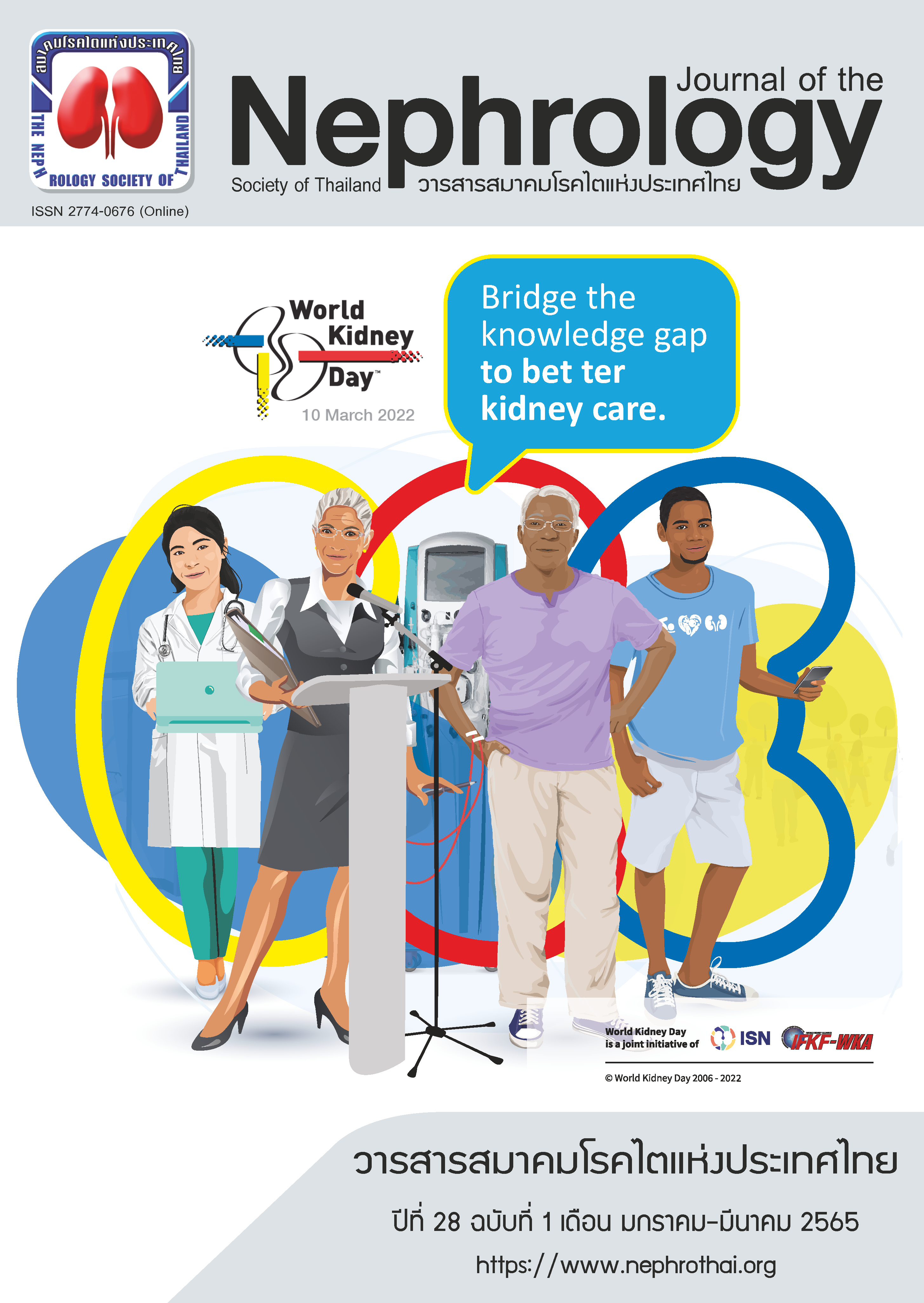อัตราการรอดชีวิตและปัจจัยที่มีผลต่อการรอดชีวิตในโรงพยาบาลของผู้ป่วยวิกฤตที่ได้รับเครื่องช่วยพยุงการทำงานของหัวใจและปอดร่วมกับการบำบัดทดแทนไตการศึกษาเดี่ยวแบบย้อนหลัง
Main Article Content
บทคัดย่อ
บทนำ: การเกิดภาวะไตวายเฉียบพลันเป็นภาวะแทรกซ้อนที่พบได้บ่อยในผู้ป่วยวิกฤตที่มีภาวะการทำงานของหัวใจและ/หรือปอดล้มเหลวที่ต้องใช้เครื่องพยุงการทำงานของหัวใจและปอด ภาวะน้ำเกินความผิดปกติของเกลือแร่หรือความเป็นกรด-ด่าง เป็นผลตามมาจากการมีภาวะไตวายเฉียบพลัน ผู้ป่วยกลุ่มนี้ที่มีภาวะไตวายเฉียบพลันที่ได้รับการบำบัดทดแทนไต (renal replacement therapy, RRT) ซึ่งมีความเสี่ยงต่ออัตราเสียชีวิตสูง ถึงแม้ว่าการบำบัดทดแทนไตเป็นมาตรฐานการดูแลรักษาผู้ป่วยกลุ่มภาวะไตวายเฉียบพลัน แต่ยังไม่มีเวลาที่เหมาะสมสำหรับการเริ่มการบำบัดทดแทนไต
วิธีการศึกษา: การวิจัยนี้เป็นแบบการศึกษาแบบย้อนหลังในศูนย์การศึกษาเดี่ยว ใน 5 ปีย้อนหลัง รวบรวมผู้เข้าร่วมการศึกษาวิจัยที่ได้รับเครื่องช่วยพยุงการทำงานของหัวใจและปอดและการบำบัดทดแทนไตในโรงพยาบาลสงขลานครินทร์ กำหนดผู้ป่วย 2 กลุ่ม คือ กลุ่มที่ได้รับการบำบัดทดแทนไตก่อนได้รับเครื่องช่วยพุงหัวใจและปอด (initiation of RRT before ECMO) และกลุ่มที่ได้รับการบำบัดทดแทนไตหลังได้รับเครื่องช่วยพุงหัวใจและปอด (initiation of RRT after ECMO) โดยใช้เวลาเริ่มการบำบัดเป็นการกำหนด โดยมีวัตถุประสงค์หลักคืออัตราเสียชีวิตในโรงพยาบาล
ผลการศึกษา: มีผู้เข้าร่วมการศึกษาวิจัยนี้ทั้งหมด 40 ราย โดยทั้ง 2 กลุ่มไม่พบความแตกต่างระหว่างข้อมูลพื้นฐาน ยกเว้นอัตราการกรองของไตเบื้องต้น ค่ากรด-ด่าง ระดับแลคเตท และคะแนน SOFA อัตราเสียชีวิตไม่แตกต่างกันในทั้ง 2 กลุ่มโดยคิดเป็นร้อยละ 76.9 ในกลุ่มที่ได้รับการบำบัดทดแทนไตก่อนเครื่องพยุงหัวใจและปอดเทียบกับร้อยละ 88.9 ในกลุ่มหลังอย่างไม่มีนัยสำคัญทางสถิติ (P=0.321) จาก multivariable adjustment Cox regression พบว่าการเริ่มการบำบัดทดแทนไตก่อนเครื่องพยุงหัวใจและปอดลดอัตราเสียชีวิตได้อย่างมีนัยสำคัญทางสถิติ (HR, 0.067; 95% CI, 0.01-0.457; P=0.006) โดยมีปัจจัยอื่น ๆ ที่มีผลต่ออัตราเสียชีวิตคือ อายุ ≥ 60 ปี 6.334 (1.268-31.625) APACHE II score เท่ากับ 1.093 (1.007-1.187) และอัตราการกรองของไตมากกว่าเท่ากับ 60 มล./นาที/1.73 ตารางเมตรเท่ากับ 0.970 (0.946-0.996)
สรุป: ผู้ป่วยที่ได้รับเครื่องช่วยพยุงการทำงานของหัวใจและปอดและการบำบัดทดแทนไตไม่มีความแตกต่างของอัตราการเสียชีวิตในโรงพยาบาล อัตราเสียชีวิตลดลงในกลุ่มผู้ป่วยที่ได้รับการบำบัดทดแทนไตก่อนได้รับเครื่องพยุงหัวใจและปอดอย่างมีนัยสำคัญทางสถิติ ปัจจัยที่เพิ่มอัตราเสียชีวิต ได้แก่ อายุ, APACJE II score ปัจจัยที่ลดอัตราเสียชีวิต ได้แก่ อัตราการกรองของไตมากกว่าเท่ากับ 60 มล./นาที/1.73 ตารางเมตร
Article Details

This work is licensed under a Creative Commons Attribution-NonCommercial-NoDerivatives 4.0 International License.
บทความนี้ตีพิมพ์ภายไต้การอนุญาต CC BY-NC-ND 4.0 ซึ่งอนุญาตให้สามารถใช้บทความนี้พื่อวัตถุประสงค์ใดๆ ก็ตามที่ไม่ใช่เชิงพาณิชย์ โดยต้องมีการอ้างถึงที่มาของบทความอย่างครบถ้วน ใครก็ตามสามารถคัดลอกและแจกจ่ายทุกส่วนของบทความนี้โดยไม่ต้องขออนุญาตจากผู้ประพันธ์หรือสมาคมโรคไตแห่งประเทศไทย
References
Lin CY, Chen YC, Tsai FC, Tian YC, Jenq CC, Fang JT, et al. RIFLE classification is predictive of short-term prognosis in critically ill patients with acute renal failure supported by extracorporeal membrane oxygenation. Nephrol Dial Transplant. 2006;21: 2867–73.
Yan X, Jia S, Meng X, Dong P, Jia M, Wan J, et al. Acute kidney injury in adult postcardiotomy patients with extracorporeal membrane oxygenation: Evaluation of the RIFLE classification and the Acute Kidney Injury Network criteria. Eur J Cardiothorac Surg. 2010;37: 334–8.
Thiagarajan RR, Brogan TV, Scheurer MA, Laussen PC, Rycus PT, Bratton SL. Extracorporeal membrane oxygenation to support cardiopulmonary resuscitation in adults. Ann Thorac Surg. 2009; 87:778–85.
David JA, David TS, Matthew LP, David SC, Brian CB, Michael Z, et al. Renal replacement therapy in critically ill patients receiving extracorporeal membrane oxygenation. Clin J Am Soc Nephrol. 2012;7: 1328–36.
Paek JH, Park S, Lee A, Park S, Chin HJ, Na KY, et al. Timing for initiation of sequential continuous renal replacement therapy in patients on extracorporeal membrane oxygenation. Kidney Res Clin Pract. 2018; 37(3):239-247.
Kidney disease: improving global outcomes (KDIGO) acute kidney injury work group. KDIGO clinical practice guideline for acute kidney injury. Kidney Int Suppl 2012; 2:1-138.
Mehta RL. Indications for dialysis in the ICU: renal replacement vs. renal support. Blood Purif 2001;19: 227-32.
Bellomo R, Ronco C, Kellum JA, Mehta RL, Palevsky P. Acute Dialysis Quality Initiative workgroup. Acute renal failure - definition, outcome measures, animal models, fluid therapy and information technology needs: the Second International Consensus Conference of the Acute Dialysis Quality Initiative (ADQI) Group. Crit Care 2004;8: R204-R212.
Zarbock A, Kellum JA, Schmidt S, Aken HV, Wempe C, Pavenstädt H, et al. Effect of early vs delayed initiation of renal replacement therapy on mortality in critically ill patients with acute kidney injury the ELAIN randomized clinical trial. JAMA 2016;315: 2190-9.
Karvellas CJ, Farhat MR, Sajjad I, Mogensen SS, Leung AA, Wald R, et al. A comparison of early versus late initiation of renal replacement therapy in critically ill patients with acute kidney injury: a systematic review and meta-analysis. Crit Care. 2011;15(1):R72.
Combes A, Bréchot N, Amour J, et al. Early high-volume hemofiltration versus standard care for post-cardiac surgery shock. The HEROICS study. Am J Respir Crit Care Med. 2015; 192:1179-90.
Clark EG, Bagshaw SM. Unnecessary renal replacement therapy for acute kidney injury is harmful for renal recovery. Semin Dial. 2015; 28:6-11.
Gaudry S, Hajage D, Schortgen F, Martin-Lefevre L, Pons B, Boulet E, et al. Initiation Strategies for Renal-Replacement Therapy in the Intensive Care Unit. N Engl J Med. 2016; 375(2):122-33.
Askenazi DJ, Ambalavanan N, Hamilton K, Cutter G, Laney D, Kaslow R, et al. Acute kidney injury and renal replacement therapy independently predict mortality in neonatal and pediatric noncardiac patients on extracorporeal membrane oxygenation. Pediatr Crit Care Med. 2011; 12(1):e1-6.
Shaheen IS, Harvey B, Watson AR, Pandya HC, Mayer A, Thomas D. Continuous venovenous hemofiltration with or without extracorporeal membrane oxygenation in children. Pediatr Crit Care Med. 2007;8:362–5.
Cavagnaro F, Kattan J, Godoy L, Gonzáles A, Vogel A, Rodríguez JI, et al. Continuous renal replacement therapy in neonates and young infants during extracorporeal membrane oxygenation. Int J Artif Organs. 2007; 30(3):220-6.
Meyer RJ, Brophy PD, Bunchman TE, Annich GM, Maxvold NJ, Mottes TA, et al. Survival and renal function in pediatric patients following extracorporeal life support with hemofiltration. Pediatr Crit Care Med. 2001; 2(3):238-42.
Weber TR, Connors RH, Tracy TF Jr, Bailey PV, Stephens C, Keenan W. Prognostic determinants in extracorporeal membrane oxygenation for respiratory failure in newborns. Ann Thorac Surg. 1990;50: 72–3.
Sell LL, Cullen ML, Whittlesey GC, Lerner GR, Klein MD. Experience with renal failure during extracorporeal membrane oxygenation: treatment with continuous hemofiltration. J Pediatr Surg. 1987;22: 600–2.
Seon SH, Hyun JK, Seung JL, Woo JK, Youngi H, Hui YL, et al. Effects of renal replacement therapy in patients receiving extracorporeal membrane oxygenation: A Meta-Analysis. Ann Thorac Surg. 2015;100: 1485–95.
Gentric A, Cledes J. Immediate and long-term prognosis in acute renal failure in the elderly. Nephrol Dial Transplant. 1991;6: 86–90.
Klouche K, Cristol JP, Kaaki M, Turc-Baron C, Canaud B, Beraud JJ. Prognosis of acute renal failure in the elderly. Nephrol Dial Transplant. 1995; 10(12): 2240-3.
Ali T, Khan I, Simpson W, Prescott G, Townend J, Smith W, et al. Incidence and outcomes in acute kidney injury: a comprehensive population-based study. J Am Soc Nephrol. 2007; 18(4):1292-8.
Murugan R, Wen X, Keener C, Pike F, Palevsky PM, Unruh M, et al. Predicting renal recovery after dialysis requiring. acute kidney injury. Kidney Int Rep. 2019; 4: 571–81.

